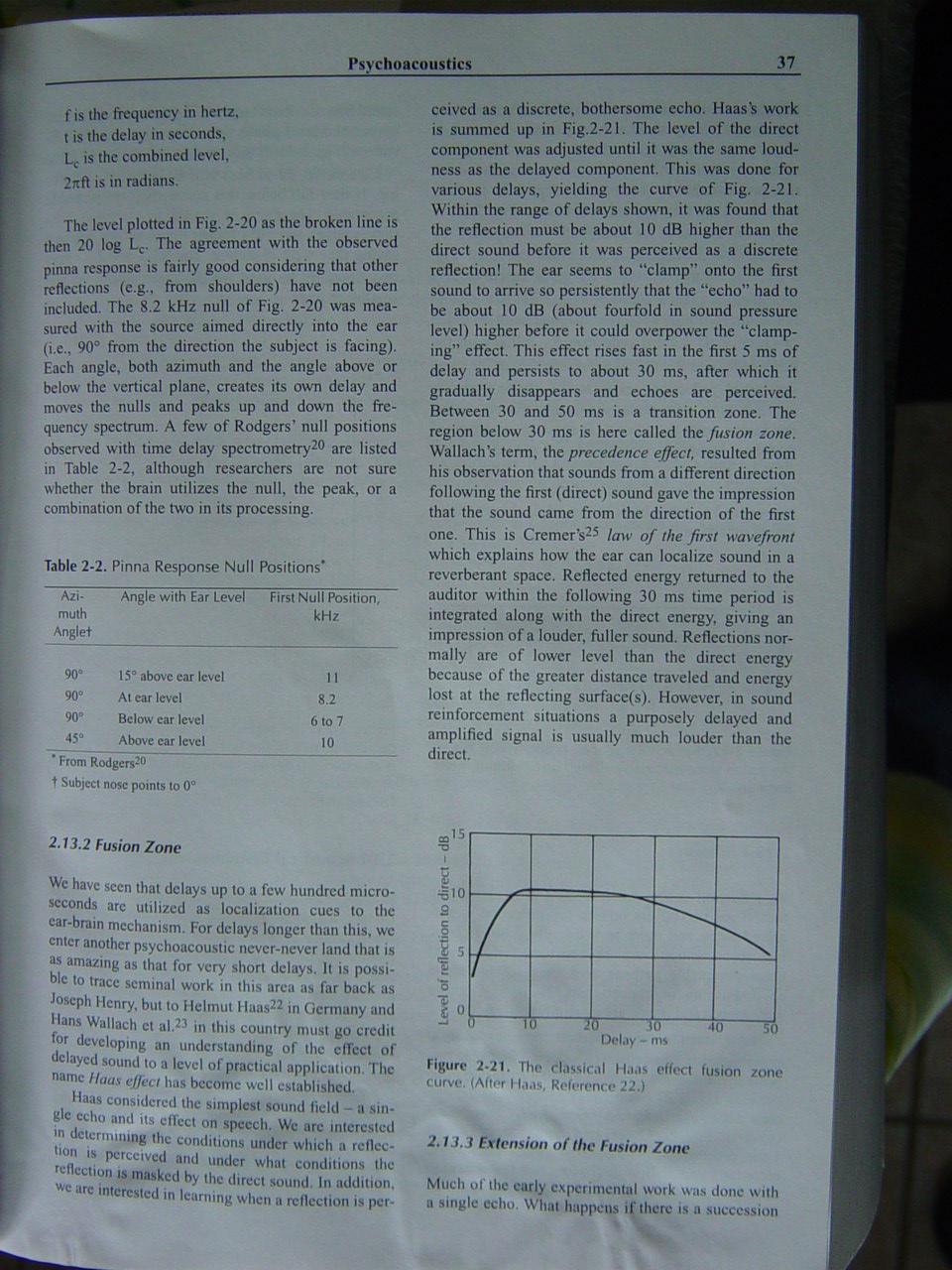- 声学楼论坛 (http://874085.11480.vipsjym.com.my3w.com/bbs/index.asp)
-- 基础理论室 (http://874085.11480.vipsjym.com.my3w.com/bbs/list.asp?boardid=17)
---- 哈斯效应 (http://874085.11480.vipsjym.com.my3w.com/bbs/dispbbs.asp?boardid=17&id=10176)
-- 发布时间:2007-7-29 4:03:07
-- 哈斯效应
从百度查到的是
哈斯效应
当两个强度相等而其中一个经过延迟的声音同时到聆听者耳中时,如果延迟在30ms以内,听觉上将感到声音好像只来自未延迟的声源,并不感到经延迟的声源存在。当延迟时间超过30ms而未达到50ms时,则听觉上可以识别出已延迟的声源存在,但仍感到声音来自未经延迟的声源。只有当延迟时间超过 50ms以后,听觉上才感到延迟声成为一个清晰的回声。这种现象称为哈斯效应,有时也称为优先效应。
-- 发布时间:2007-7-29 4:04:12
--
还贴个从一本书上拍的.
 此主题相关图片如下:dsc04112.jpg
此主题相关图片如下:dsc04112.jpg
-- 发布时间:2007-7-29 17:01:48
--
是不是可以推论:
音箱的面板区域的反射、散射、衍射(30CM以内,延时<= 1MS)没有哈斯效应,对听觉影响巨大.
而房间的反射、散射、衍射等(60CM到10M范围,2MS >= 延时<=30 MS )受哈斯效应屏蔽,对听觉影响可忽略.


-- 发布时间:2007-7-29 23:17:32
--
关于哈斯效应的定义南大的培训教材上有明确的定义
-- 发布时间:2007-7-30 12:38:54
--
是不是可以推论:
音箱的面板区域的反射、散射、衍射(30CM以内,延时<= 1MS)没有哈斯效应,对听觉影响巨大.
而房间的反射、散射、衍射等(60CM到10M范围,2MS >= 延时<=30 MS )受哈斯效应屏蔽,对听觉影响可忽略.


哈斯效应是讲分辨来自不同声源的同样的声音的听觉效应.
-- 发布时间:2007-7-30 12:41:16
--
关于哈斯效应的定义南大的培训教材上有明确的定义
不好讲是定义,应该是描述,南大的培训教材上,我想应该有吧.
-- 发布时间:2007-7-30 12:44:24
--
再贴上一段维基百科的,是英文的.
Haas effect
From Wikipedia, the free encyclopedia
The Haas effect is a psychoacoustic effect related to a group of auditory phenomena known as
the Precedence Effect or law of the first wave front. These effects, in conjunction with
sensory reaction(s) to other physical differences (such as phase differences) between
perceived sounds, are responsible for the ability of listeners with two ears to accurately
localize sounds coming from around them.
When two identical sounds (i.e. identical sound waves of the same perceived intensity)
originate from two sources at different distances from the listener, the sound created at
the closest location is heard (arrives) first. To the listener, this creates the impression
that the sound comes from that location alone due to a phenomenon that might be described as
"involuntary sensory inhibition" in that one\'s perception of later arrivals is suppressed.
The Haas effect occurs when arrival times of the sounds differ by up to 30 - 40
milliseconds. As the arrival time (in respect to the listener) of the two audio sources
increasingly differ beyond 40ms, the sounds will begin to be heard as distinct; in audio-
engineering terms the increasing time difference is described as a delay (audio effect) , or
in common terms as an echo (phenomenon)
The Haas effect is often used in Public Address systems to ensure that the perceived
location and/or direction of the original signal (localization) remains unchanged. In some
instances, usually when serving large areas and/or large numbers of listeners, loudspeakers
must be placed at some distance from a stage or other area of sound origination. The signal
to these loudspeakers may be electronically or otherwise delayed for a time equal to or
slightly greater than the time taken for the original sound to travel to the remote
location. This serves to ensure that the sound is perceived as coming from the point of
origin rather than from a loudspeaker that may be physically nearer the listener. The level
of the delayed signal may be up to 10 dB louder than the original signal at the ears of the
listener without disturbing the localization.
The Haas effect is also responsible in large part for the perception that a complete complex
audio field is reproduced by only two sound sources in stereophonic and other binaural audio
systems and it is also utilized in the generation of more sophisticated audio effects by
devices such as matrix decoders in surround sound technologies, such as Dolby Pro Logic.
For a time in the 1970\'s, Audio Engineers used the Haas effect to simulate that a sound was
coming from a single speaker in a stereo sound system, when it was actually coming from
both. This was to compensate for the fact that a sound coming from a single speaker would be
3db lower in volume than a sound coming from both. This technique has problems if the stereo
sound is mixed to mono, as a Comb filter effect would occur. Also, the Aesthetics of sound
mixing changed to exclude the use of solo instruments emanating from a single corner of the
sound field in most popular recordings.
Named after Helmut Haas who described the effect in his doctoral dissertation "Über den
Einfluss eines Einfachechos auf die Hörsamkeit von Sprache" to the University of Göttingen,
Germany. An English translation was published in December,1949. [1]
-- 发布时间:2007-7-30 13:18:53
--
学习了!哈斯效应一词以前的印象非常模糊,谢谢前辈详细分解。
-- 发布时间:2007-7-30 17:13:36
--
哈斯效应是讲分辨来自不同声源的同样的声音的听觉效应.
那些反射、散射、衍射波们正是来自不同方向但是同样的声音呀.
是不是它们虽搅乱了频响,但却听不出来,感觉不到这种搅乱的频响.
若是心理效应,是否有人的感觉不同呢?
-- 发布时间:2007-7-30 23:51:42
--
那些反射、散射、衍射波们正是来自不同方向但是同样的声音呀.
是不是它们虽搅乱了频响,但却听不出来,感觉不到这种搅乱的频响.
若是心理效应,是否有人的感觉不同呢?
听觉系统的奥秘不光是一个哈斯效应,
哈斯先生是针对那样两个声源做的实验,然后总结出规律性的东西,
就称之谓哈斯效应了.
"若是心理效应,是否有人的感觉不同呢?"
是因人有小异的,但是有平均的说法,请看上面资料中关于50MS,40MS,30MS的一些说法.
"反射、散射、衍射波们正是来自不同方向但是同样的声音呀."
在人的听觉系统中当然也有效应,在50MS内到达的是有益的,...
那要好好调出书来看的啊.
-- 发布时间:2007-7-31 0:18:02
--
在设计音乐厅或听音室时,控制“混响时间”使声音清晰度不受影响的同时,声音又变得更加“丰富饱满”,这应该是哈斯效应的具体应用吧。(?)
-- 发布时间:2007-7-31 12:02:27
--
在设计音乐厅或听音室时,控制“混响时间”使声音清晰度不受影响的同时,声音又变得更加“丰富饱满”,这应该是哈斯效应的具体应用吧。(?)
这个问题是不好直接答YES和NO.
音乐厅和听音室的设计是不同的出发点.
要想多少搞请一些就是要从两方面去学习,
一是建筑声学,二是心理声学,
或者说,一是房间内声波的物理特征,
二是人在那个环境中的感受,..
......
一句两句是讲不完的.
起码是要读或翻一下管善群教授的
<电声技术基础>.
英文资料当然多,也容易从网上取得.
-- 发布时间:2007-7-31 17:55:38
--
嗯嗯,向前辈好好学习
-- 发布时间:2007-7-31 19:50:05
--
音乐厅和听音室的设计是不同的出发点.————
的确是这样!
音乐厅更偏重建筑声学的“应用”或者说对反射、混响的利用;以求得到平衡、丰富、饱满的效果。
听音室则应该尽量减少建筑声学的反射、混响产生的影响;以求得到平衡、准确的声象还原。
为了尽量减少“添加”环境反射、混响、驻波等的影响,听音室往往需要进行吸音、扩散处理。处理重点应该针对低频的吸收(扩散)处理,防止中频特别是高频吸音过量。
但是业余条件下,通常吸音处理严重失去“平衡”,中频特别是高频吸收处理容易出现相对“严重吸收过量”,低频吸收处理相对又出现“严重不足”,这是一个非常普遍的现象和问题,…………90%有这样的倾向性问题吧…………
不好意思,把话题扯远了!
-- 发布时间:2007-8-27 20:01:16
--
哈斯效应————是不是多轨录音常常被用来“制造声场”、“调整乐器定位”的手段呢?
-- 发布时间:2007-8-28 7:24:36
--
哈斯效应————是不是多轨录音常常被用来“制造声场”、“调整乐器定位”的手段呢?
最近是泛泛而读些书,没有深入读书和实验,所以没法作好回答.
大概地讲,50MS确认算是一个重要的值,人耳接受了直达声后的50MS内所获得的直达声的反射声对人耳
的听觉确实是重要的.
-- 发布时间:2007-9-2 0:20:38
--
50MS的延时,用电子延时器很轻易就能办到;实际听音环境里,这个反射声就需要比直达声“多走过”大约17m的距离;这就需要一个比较大的听音环境,如歌剧院、大礼堂等。其他如一般公司的中小会议室、小礼堂、私人的家庭听音环境等,大多数都在200平方米以内,它们是没有条件满足这个条件的,哈斯效应也就应该不能明确地表现出来。
但是,我们在家庭听音室聆听立体声音乐的时候,声象定位确实非常明确,声象定位完全离开了两只音箱(声源),这就是发烧友常常说的“离箱感”,并可以再现出一个声象可信度很好的、每件乐器或者每个歌唱家都有其明确定位的“虚拟舞台”。
这是什么原因引起的呢?我想,这个现象应该有其他的理论去解释的,有谁了解这些相关的理论吗?哪怕一丁点也好,真诚地盼望各位老师前辈们多多赐教!!
希望畅所欲言,谢谢!!
-- 发布时间:2007-9-3 17:12:36
--
继续学习
-- 发布时间:2007-9-22 16:02:58
--
路过

-- 发布时间:2007-9-30 15:13:28
--
要学习英文了